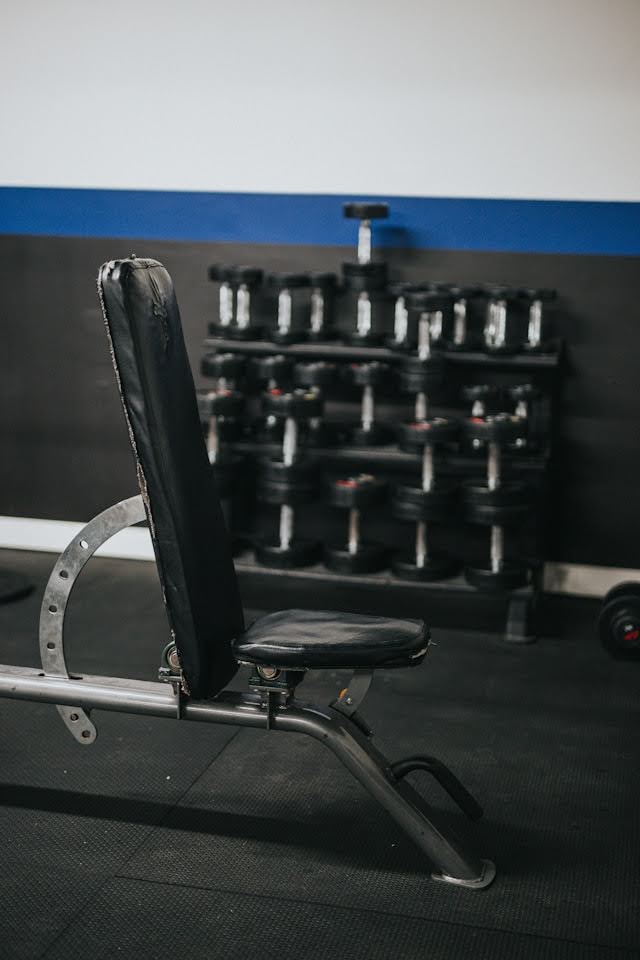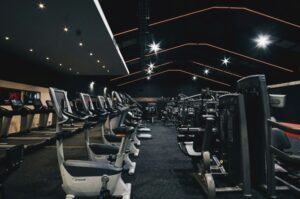
Introduction
A weight bench is much more than a simple piece of gym equipment. It is a versatile tool that can be utilised to target different muscle groups in the upper body. Whether you are a beginner or an experienced fitness enthusiast, mastering weight bench basics is essential for effective strength training and muscle building.
Understanding how to properly use a weight bench can help you maximize your workout potential and avoid injuries. In this beginner’s guide, we will explore the benefits of weight bench training, the essential equipment you need, and the proper techniques to use for various exercises. We will also provide a list of top weight bench exercises for beginners and tips on progressing with your workouts.
By the end of this guide, you will have a solid foundation of knowledge to confidently incorporate weight bench exercises into your fitness routine and achieve your fitness goals. So let’s dive in and master weight bench basics!
Understanding the Benefits of Weight Bench Training
Weight bench training offers numerous benefits for individuals looking to improve their overall fitness and strength. By incorporating weight bench exercises into your training routine, you can effectively target and strengthen your upper body muscles, including the chest, shoulders, triceps, and core.
Weight bench exercises like the bench press are fantastic for building upper body strength and muscle mass. They primarily target the chest, shoulders, and triceps, but also engage various stabilising muscles throughout the body, including the core, to maintain proper form and balance. This not only improves strength but also enhances overall stability and coordination. Plus, the endurance gained from these exercises can make everyday activities feel easier and more manageable. It’s a well-rounded workout for anyone looking to strengthen and tone their upper body while improving functional fitness.
Whether your goal is to build muscle strength, improve upper body aesthetics, or enhance overall fitness, weight bench training is a valuable tool that can help you achieve your goals.
Building Muscle Strength and Endurance
Weight bench training is highly effective for building upper body strength and endurance. Exercises like the bench press specifically target the chest, shoulders, and triceps. By progressively increasing weights, you can enhance muscle strength and definition. Additionally, stabilising muscles such as the biceps and core are engaged during these exercises. This training boosts endurance by making muscles work harder over time, enabling you to lift heavier weights without quick fatigue. Overall, weight bench training is an excellent method for developing upper body strength and endurance.
Enhancing Core Stability and Balance
Weight bench training not only builds muscle strength but also improves core stability and balance. These exercises require proper form and engagement of core muscles, including the abs, lower back, and hips, to maintain stability. Strengthening these muscles enhances overall balance and performance in various activities. To engage core muscles effectively, maintain a neutral spine, activate the abs, and avoid excessive arching or rounding of the back during weight bench exercises.
Preparing for Weight Bench Exercises: What You Need
Before diving into weight bench exercises, it is important to ensure that you have the necessary equipment and knowledge to perform them safely and effectively.
Various types of weight benches are available, including adjustable benches that allow you to change the incline or decline position. Choose a bench that suits your needs and provides proper support and stability during exercises.
In addition to a weight bench, you will also need essential equipment such as dumbbells, barbells, or kettlebells, depending on the specific exercises you plan to perform. These weights will allow you to progressively increase the load and challenge your muscles.
Establishing the proper starting position is important before beginning any weight bench exercise. This includes setting up the bench at the appropriate incline or decline angle, adjusting the seat and backrest for comfort, and positioning your body in a stable and balanced manner.
By ensuring you have the right equipment and proper setup, you can perform weight bench exercises safely and effectively, maximising your workout benefits.
Selecting the Right Weight Bench for Your Needs
Selecting the right weight bench involves considering a few factors.
- For home gyms, opt for an adjustable weight bench for versatility in workouts. Ensure it’s sturdy enough for your lifting needs.
- In commercial gyms, benches must handle heavy usage and multiple users. Prioritise durability and high weight capacity.
- Consider the available space; choose foldable benches for smaller areas. Look for adjustable features for customsation to your needs.
Essential Equipment and Accessories
In addition to the weight bench, there are a few essential equipment and accessories that can enhance your weight bench workouts.
- A pair of dumbbells: Dumbbells are versatile and can be used for various exercises such as chest press, bicep curls, and shoulder presses. They allow for greater range of motion and targeting specific muscle groups.
- Workout bench: A workout bench provides stability and support during exercises. Look for a bench that is adjustable to different angles, allowing for a variety of exercises and targeting different muscle groups.
- Resistance bands: Resistance bands can be used to add extra resistance to your workouts, providing a challenge and helping to build strength. They are portable and can be easily incorporated into your weight bench exercises.
- Weight plates: Weight plates can be added to a barbell or dumbbell to increase the resistance and intensity of your workouts. They are essential for progressive overload, which is key for muscle growth and strength development.
By including these essential equipment and accessories in your weight bench workouts, you can optimise your training and achieve better results.
The Beginner’s Guide to Using a Weight Bench
Mastering the basics of using a weight bench is important for a safe and effective workout, whether you’re a beginner or have some experience. The beginner’s guide involves understanding the proper starting position, body alignment, and executing exercises with proper form. Here are the key points to notice for beginners when using a weight bench:
Setting Up Your Weight Bench Safely
- Before starting any exercise, ensure the weight bench is correctly set up and adjusted to the desired angle based on the specific exercise and muscle group you’re targeting.
Proper Body Alignment and Starting Position
By maintaining proper alignment and position, you can perform weight bench exercises with better form and maximise workout effectiveness.
Ensure your body is aligned with the bench, keeping your back straight, shoulders down and back, and core engaged for stability. Position your head, neck, and spine neutrally to avoid strain, and secure your feet for stability. Grip weights with neutral wrists and a comfortable yet firm grip. This attention to alignment enhances both safety and effectiveness during your workout.
Form Execution
Form execution is paramount in weight bench exercises. This involves controlling weights meticulously, ensuring a full range of motion, and directing focus to the targeted muscle group. By adhering to proper form, individuals can optimise muscle engagement, minimise the risk of injury, and achieve better overall results in their workouts.
Safety measure
Safety measures are critical when using a weight bench. Starting with lighter weights allows individuals to master proper form and technique before progressing to heavier loads, reducing the risk of injury. Gradually increasing intensity ensures steady progress while minimising the likelihood of overexertion or strain. By prioritising safety measures, individuals can create a safe and effective workout environment, promoting long-term success and injury prevention.
Muscle Targeting
Understanding how to target specific muscle groups through bench press variations is crucial for a well-rounded workout routine. By adjusting the bench angle and hand positioning, you can effectively target different areas of the chest and shoulders. For instance, the incline bench press targets the upper chest and front shoulders, while the decline bench press focuses on the lower chest and triceps.
Additionally, incorporating dumbbells or resistance bands provides further options for muscle targeting. Varying your bench press routine in this way ensures a comprehensive upper body workout, promoting muscle growth and balance.
Listening to your body
Listening to your body is an essential aspect of any workout routine. Pay attention to how you feel – if you’re tired or in pain, it’s okay to take it easy. Push yourself when you feel strong, but don’t overdo it. This helps prevent injuries and ensures a safer, more enjoyable workout experience.
Top Weight Bench Exercises for Beginners
For beginners starting weight bench workouts, key exercises target upper body muscles for strength training. Incorporate these exercises to build a strong upper body foundation for advanced workouts.
- Dumbbell chest press: Targets chest and triceps on flat or incline bench.
- Seated shoulder press: Focuses on shoulders and upper arms with dumbbells or barbell on flat/incline bench.
- Tricep dips: Strengthen triceps and arms on bench edge with feet on ground.
- Incline dumbbell flyes: Target upper chest muscles on incline bench with dumbbells.
Top Weight Bench Exercises for Beginners
As you gain confidence with weight bench workouts, it’s vital to advance your training to keep challenging your muscles and reaching your fitness targets. This could involve increasing weights, adding more repetitions, or trying new exercises to keep your workouts effective and engaging.
By progressing gradually, you can avoid plateaus and continue making gains in strength and muscle development.
Increasing Weights and Repetitions
One way to advance is by gradually increasing the weight load as your muscles become stronger, pushing your limits and stimulating further muscle development.
Additionally, increasing the number of repetitions or sets of exercises enhances muscular endurance and workload capacity. It’s crucial to listen to your body, progress slowly to avoid injuries, and maintain proper form throughout. Consistent progression in your workouts will effectively lead you to achieve your fitness goals.
Introducing Advanced Exercises
Once you have mastered the basic weight bench exercises, it’s time to introduce more advanced exercises into your training routine. These exercises offer greater challenge and target different muscle groups, providing a more well-rounded workout.
Some advanced weight bench exercises you can incorporate include:
- Single-arm dumbbell row: This exercise targets the back muscles (lats) and shoulders. It involves rowing a dumbbell up towards your waist while stabilizing your body with one arm on the bench.
- Chest-supported dumbbell row: This exercise targets the upper back muscles (rhomboids and trapezius) and shoulders. It involves lying face down on an incline bench and rowing dumbbells up towards your ribcage.
- Plyometric push-ups: This exercise targets the chest, shoulders, and triceps while also incorporating explosive movements. It involves performing push-ups with an explosive push-off, allowing your hands to leave the ground.
Introducing advanced exercises adds variety and challenges your muscles in different ways. It also helps improve overall strength, stability, and muscle coordination.
By incorporating advanced weight bench exercises into your training routine, you can continue to progress and achieve your fitness goals.
Conclusion
Mastering weight bench basics is essential for beginners looking to enhance their strength and endurance. Understanding the benefits of weight bench training, selecting the right equipment, and employing proper techniques are key steps in achieving fitness goals. By incorporating variations and progressing gradually, individuals can build muscle and increase core stability effectively. Consistency, safety, and dedication are crucial aspects of weight bench workouts. Embrace the journey with enthusiasm, focus on correct form, and gradually challenge yourself to achieve optimal results in your fitness journey. Start your weight bench training today and witness your progress unfold with commitment and perseverance.
Frequently Asked Questions
Beginners can start using a weight bench 2-3 times per week. It’s important to give your muscles time to recover between workouts. As you become more experienced, you can gradually increase the frequency to 4-5 times per week, depending on your fitness goals.
Weight bench exercises should not be done every day. Your muscles need time to recover and rebuild after each workout. It is recommended to have at least one day of rest between weight bench workouts to allow for proper recovery and muscle growth.
Both free weights (dumbbells and barbells) and machines have their advantages. Free weights offer greater stability and engage stabilising muscles, while machines provide more guided and controlled movements. Incorporate a mix of both for a well-rounded workout.
If you have shoulder or back pain, it’s essential to consult with a healthcare professional before engaging in weight bench exercises. They can provide guidance on modifications or alternative exercises to avoid exacerbating existing injuries.
Stop the exercise immediately if you experience pain or discomfort beyond normal muscle fatigue.



